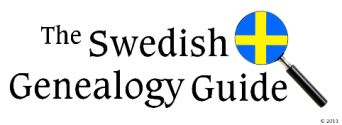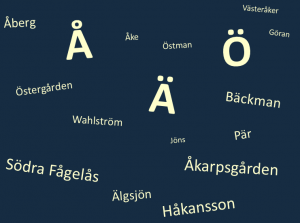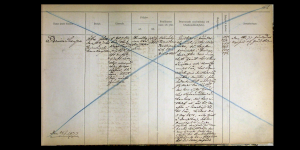Family Secrets
This episode begins with a man named Kjell Weber of Torslanda who shared 2 family secrets. One was a family story that had been passed down for generations. The story goes that the family name of Ödman went back to an English seaman whose last name was Smith. He was shipwrecked and came ashore to an island called Skaftö which is off the coast of Bohuslän by floating on a plank. Then he found an abandoned house (Ödehus) where he settled down and stayed. Smith eventually changed his last name to Ödman as a variation on the name of the house. Kjell found that an early generation had sons that simply took the name Ödman to replace their patronymic names. When Kjell shared this with his family, an Aunt was not happy to hear the truth. Elisabeth Renström summarized that this story had been passed down for generations, but it turned out to be just a story. The English seaman whose name was Smith had never existed and some of the modern family was not happy to hear the truth.
The episode transitions to another interesting topic, the naming patterns of given names in Sweden. Elisabeth Renström met with Margareta Svahn, a manager with the Dialect, Place Name, and Cultural Archive (Dialekt ortnamns och folkminnesarkivet) in Göteborg. Magareta shared some interesting points regarding “given names” such as:
- In rural areas many people named their children according to “traditional given names” in the family. For example, they might name the first son after the father’s father and the first daughter after the mother’s mother.
- You’ll see that some given names were popular in an area, such as many parents naming their sons Per, Anders, or Karl in a village.
- By the 1700’s and 1800’s people started to use given names from other countries. Naming practices changed first in the cities, and then eventually in rural areas.
- The first group in society to use foreign given names was the townsman, or citizen social class (the Borgare.)
- Some illegitimate children were given unusual first names because 1. The unwed mother may have been employed as a household servant by the borgare (she was influenced by non-traditional names) and 2. Having a child out of wedlock had a negative social stigma so the mother might break from family traditions.
- A child’s given name might have been influenced by the priest. There are examples where the priest was told by the parents what the name should be (even written on paper), but the priest didn’t like it so he chose something else.
- The priest might have christened the child according to a proper form of the name. For example, the parents requested Kajsa but he recorded the name as Karen or Katarina. The child’s name is recorded in the birth record as Karen or Katarina but she was known throughout her life as Kajsa.
- Although a child’s name was recorded in the birth record with one spelling, it doesn’t mean that anyone kept using that spelling in other records.
- During Viking and early Medieval times people used Nordic names (such Asmund, Ingrid, and Sven.) Christianity brought a variety of given names, especially from the liturgical calendar such as Andreas, Johannes, Petrus that became Anders, Johan, and Per.
- The time of Sweden’s wars and expansion in the 1600’s brought names from other countries especially France and Germany. Names from other countries become popular in the 1700’s (first in the larger cities) and then in the 1800’s throughout the rest of the country.
The episode switches to the topic of a project called Namn åt de döda 1950 – 2003 (meaning Names of the dead) that was led by the Swedish Federation of Genealogical Societies (Sverige Släktforskarförbund.) The information from this project was published on a C.D. database called Sveriges Dödbok (maning Swedish Death Book), which has multiple versions (latest is 1901 – 2009 that has about 7.1 million people in it.) The database includes other information such as birthdate, their personal i. d. number (if the person died after 1947), social standing, birth parish, and the residence parish at the time of death. The purpose of the database is to help people find information about when someone died without having to visit a regional archive or contact a parish. The legal responsibility for parishes to keep vital records stopped in 1991.)
Elisabeth Renström switches back to her interview with Kjell Weber who shared another piece of the family story, this time an ancestor guilty of murder. The ancestors name is Karl Johansson who was a guard at the city jail in Göteborg. One evening in the spring of 1847 Karl and a friend went out for a walk. They went down a darkened street where they ran into 3 other men, one of them being in the military. The men began to mock and insult each other, all of the men participated but it was mostly between the military man and Karl. Court documents do not show what the insults were about, but the insults turned into a fight. The story goes that suddenly Karl breaks into an insane rage; he picked up a wooden shovel that happened to be nearby and began to beat one of the 3 men who was the slowest.
Karl beat the youngest of the group, a young man named Daniel Jacobsson who worked in one of the cigar factories to death. One of the witnesses who testified in court, was a laborer named Andreas Kristensson. He described how Karl came out from a doorway with the shovel in hand to chase the young man. The city court records show that another witness described the yelling, and sounds of the blows. It was dark and somewhat unclear who actually did the beating, but another witness said it was Karl.
Karl was convicted for murder and condemned to the death by beheading. The conviction was appealed to an appellate court, but the conviction was upheld. It was appealed again to the Swedish Supreme Court with a request for mercy from the King. The King upheld the conviction but the penalty was changed to 28 days on bread and water (which was equivalent to a death sentence), public confession, and 10 years at a labor prison. Karl served his time at the labor prison in Malmö between 1848 and 1858. After his release, Karl returned to Bohuslän where he found work as a laborer, eventually married and had a family.
Kjell shared the story of the English seaman, and other stories that had been passed down to illustrate how family’s keep secrets, and other things are only partially true.
The episode ends with some research advice from Thord Bylund and Kathrine Flyborg:
– You start with building your family tree as far back as you can.
– Eventually you can’t go further back, so you work on collateral lines or pick an early ancestor and work your way down the descendants.
– The research in the 1800’s is usually the easiest to work in.
– Another research activity is to gather family photos, and then collaborate with extended family to identify the people in the photos.
What do we learn for Swedish genealogy?
- Some family stories are simply wrong, and some family members will not be happy to hear the truth.
- There is a rich and interesting history to the given names in the Swedish culture.
- The records in Sweden are very good. As you search the records you will find family secrets, or discover the truth of a family story.
Source: Släktband by Gunilla Nordlund and Elisabeth Renström
Season: 1 – Genealogy Courses and Other Useful Topics
Episode: 3 Släkthemligheter
Date of publication: 21 November, 2004
Published by: Sveriges Radio P1
Language: Swedish
Link to episode: Släktband 1:3 Släkthemligheter


